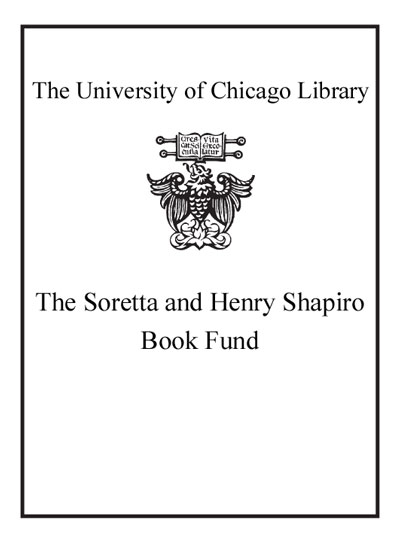Aristotle on knowledge and learning : the posterior analytics /
Saved in:
| Author / Creator: | Bronstein, David, author. |
|---|---|
| Edition: | First edition. |
| Imprint: | Oxford : Oxford University Press, 2016. |
| Description: | xii, 272 pages ; 24 cm. |
| Language: | English |
| Series: | Oxford Aristotle studies Oxford Aristotle studies. |
| Subject: | |
| Format: | Print Book |
| URL for this record: | http://pi.lib.uchicago.edu/1001/cat/bib/10745779 |
Table of Contents:
- Acknowledgements
- Abbreviations of Titles of Aristotle's Works
- Introduction
- General Introduction
- 1. Meno's Paradox
- 2. The Order of Inquiry
- 3. Nous
- 1. Meno's Paradox and the Prior Knowledge Requirement
- 1. Meno's Three Questions
- 2. Socrates's Dilemma
- 3. Meno's and Socrates's Prior Cognition Requirements
- 4. Aristotle on Learning: the Prior Knowledge Requirement
- 5. Aristotle on Knowledge
- 6. Prior Knowledge of What?
- 7. Prior Cognition and Prior Knowledge in Plato and Aristotle
- 8. Simultaneous Learning in APo 1.1
- 9. Meno's Paradox in APo 1.1
- Conclusion
- Part I. Learning by Demonstration
- 2. Learning by Demonstration
- 1. The Prevailing View
- 2. Textual Evidence
- 3. Scientific Knowledge and Demonstration: APo 1.2
- 4. What is Learning by Demonstration?
- Conclusion
- 3. Belonging 'In Itself' and Aristotle's Theory of Demonstration
- 1. Belonging 'In Itself' (Kath' Hauto): APo 1.4
- 2. In Itself 2 : Demonstrable Attributes
- 3. In Itself Accidents: Demonstrable Attributes
- 4. Two Models of Demonstration
- 4. Scientific Knowledge and Demonstration
- 1. Non-Demonstrative Scientific Knowledge (Nous)
- 2. Scientific Knowledge and Explanation
- 3. Episteme, Nous, and Logos
- 4. The Objects of Scientific Knowledge
- 5. Scientific vs. Non-Scientific Knowledge
- 6. The Requirements for Principles of Demonstration
- 7. The Prior Knowledge Requirement for Learning by Demonstration
- 8. Learning by Demonstration, Revisited
- Conclusion
- Part II. Learning by Definition
- 5. Learning by Definition: Introduction
- 1. Some Preliminaries
- 2. Learning by Demonstration and by Definition
- 6. Inquiry in APo 2.1
- 1. The Four Questions of Inquiry
- 2. Inquiry and Scientific Knowledge
- 3. Knowledge in APo 2
- 4. From Non-Scientific to Scientific Knowledge
- 5. The Objects of Inquiry
- 6. The Stages of Inquiry
- 7. Meno's Paradox
- 7. Inquiry in APo 2.2
- 1. Searching for the Middle Term
- 2. Attribute Questions
- 3. The Causal and Definitional Constraints
- 4. Meno's Paradox
- 5. The Causal Constraint for Attributes
- 6. The Definitional Constraint: Introducing Causally Complex Essences
- 7. Attributes and Subjects
- 8. The A Term
- 9. A Missing A Term?
- 10. Definition and Explanation
- 11. Subject-Focused Inquiry
- 12. Essence and Middle Term 106 Conclusion
- 8. The Socratic Picture of the Order of Inquiry
- 1. The Intuitionist Picture
- 2. The Explanationist Picture
- 3. The Socratic Picture
- 4. Three Methodological Passages
- 5. Better Known By Nature and To Us: Explanation, Conviction, and Nous
- 6. An Objection
- 9. Cause, Essence, and Definition
- 1. Causes that are the Same vs. Causes that are Different
- 2. Cause and Essence
- 3. The Two Types of Cause in APo 2.9
- 4. How Essences are Discovered
- 5. APo 2.10: Definition
- 6. Nominal Accounts in APo 2.10
- Conclusion
- 10. Discovering Causally Complex Essences: APo 2.8
- 1. The Puzzles of APo 2.3-7
- 2. The Argument of APo 2.8, 93a3-15
- 3. The Essence-Revealing Demonstration
- 4. Inquiry, Discovery, and Prior Knowledge
- 5. Knowing Part of the Essence
- 6. Knowing Part of x's Essence without Knowing that x Exists
- 7. First Route to Knowledge: Stages 3 to 4
- 8. First Solution to Meno's Paradox
- 9. Inquiring without an A Term
- 10. Discovering the Essence-Revealing Demonstration: Stages 4 to 5
- 11. The Two Models of Demonstration in APo 2.8
- 12. Second Route to Knowledge, Second Solution to Meno's Paradox
- Conclusion
- 11. Subject-Kinds and their Existence
- 1. Primary vs. Subordinate Subject-Kinds
- 2. Subject-Kinds vs. Demonstrable Attributes
- 3. Subordinate Subject-Kinds vs. Demonstrable Attributes
- 4. Demonstrating Attributes: Teaching by Demonstration, Part 1
- 5. Teaching vs. Inquiring
- 6. Demonstrating Subordinate Subject-Kinds: Teaching by Demonstration, Part 2
- 7. Discovering the Existence of Subordinate Subject-Kinds
- 8. Discovering the Existence of Primary Subject-Kinds
- 12. Discovering Causally Simple Essences: APo 2.13
- 1. Division, Definition, and Explanation
- 2. Discovering the Essences of Subject-Kinds
- 3. Genus, Differentia, and Division: An Overview
- 4. Objections to Division: APo 2.5 and 6
- 5. The D Attribute Rule
- 6. Division Introduced
- 7. Exhaustive Division
- 8. Correctly Dividing a Genus
- 9. Preliminary Conclusions
- 10. Inquiry, Division, and Meno's Paradox
- 11. Defining by Division: Conclusions
- 12. Discovering the Essences of Primary Subject-Kinds
- Part III. Learning by Induction
- 13. The Origin and Aim of APo 2.19
- 1. Opening Moves and Overview
- 2. Motivation
- 3. The Origin and Aim of APo 2.19
- 4. Meno's Paradox
- 5. Perception and Logos
- 6. Perception to Nous
- 7. Experience, Induction, and Inquiry
- 8. The Rout Simile
- 9. Perception and Induction: Preliminaries
- 10. Perception and Induction: Details
- Conclusion
- Conclusion
- Bibliography
- Index Locorum
- Index Nominum
- General Index

